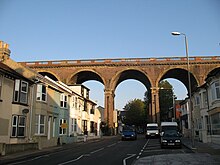London Road viaduct
| London Road Viaduct | |
|---|---|

The viaduct today
|
|
| Coordinates | 50°50′07″N 0°08′32″W / 50.8353°N 0.1421°WCoordinates: 50°50′07″N 0°08′32″W / 50.8353°N 0.1421°W |
| Carries | Railway |
| Locale | Brighton |
| Maintained by | Network Rail |
| Heritage status | Grade II*-listed |
| Characteristics | |
| Material | Brick |
| Total length | 1,200 feet (370 m) |
| Height | 67 feet (20 m) |
| No. of spans | 27 |
| History | |
| Designer | John Urpeth Rastrick |
| Construction start | 29 May 1845 |
| Construction end | 28 March 1846 |
The London Road Viaduct is a brick railway viaduct in Brighton, part of the city of Brighton and Hove in East Sussex, England. It carries the East Coastway Line between Brighton and London Road railway stations. Built in the 1840s for the Brighton, Lewes and Hastings Railway by the locomotive engineer and railway architect John Urpeth Rastrick, the sharply curving structure has 27 arches and about 10 million bricks. It is still in constant use, and is listed at Grade II* for its historical and architectural significance.
The London and Brighton Railway Act, passed on 15 July 1837, granted the London & Brighton Railway Company the right to build a railway line from Norwood to Brighton, a branch line from Brighton to Shoreham-by-Sea and another from Brighton to Newhaven via Lewes. The line to Shoreham-by-Sea was completed first, in 1840, and the Brighton Main Line opened in its entirety in September 1841; but the route eastwards from Brighton towards Lewes was delayed until 8 June 1846. A new company, the Brighton, Lewes & Hastings Railway Company, was formed to build this line; John Urpeth Rastrick was employed as the surveyor and architect. The two companies and others amalgamated in July 1846 to form the London, Brighton and South Coast Railway.
In the 1840s, the land northeast of Brighton station was undeveloped, consisting of fields. It lay in a steep-sided valley running from north to south, created by the River Wellesbourne (by then, reduced to an intermittently flowing, mostly underground winterbourne). Rastrick had to decide whether to cross this with an embankment or a viaduct. Local opinion favoured an embankment, and he faced opposition and criticism when he chose to build a viaduct. Nevertheless, he planned a route for it, and laid the foundation stone on 29 May 1845. Construction took 10 months: the structure was ready on 28 March 1846, more than two months before the line to Lewes opened. By the 1870s, dense terraced housing surrounded the viaduct: residential development was stimulated by the opening of the railway.
...
Wikipedia
